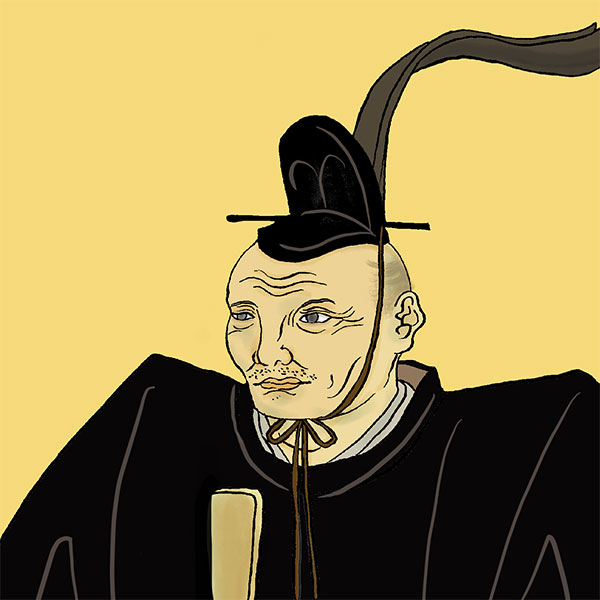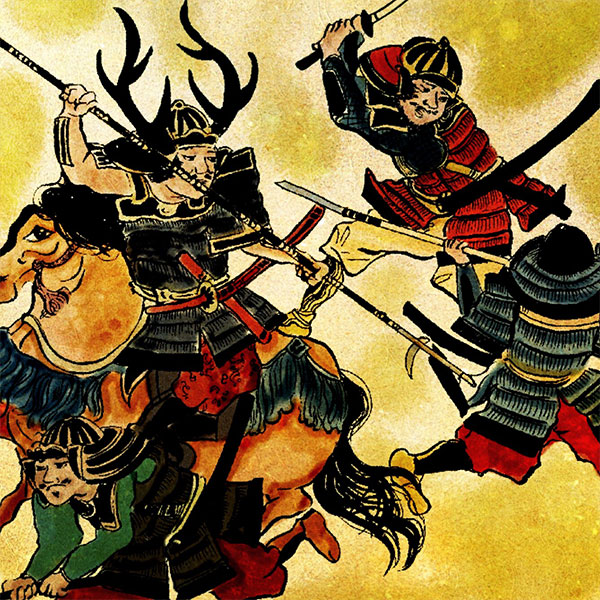Tadatoshi Hosokawa (2/2)son of garasha

Tadatoshi Hosokawa
- Article category
- biography
- name
- Tadatoshi Hosokawa (1586-1641)
- place of birth
- Kyoto
- Related castles

Kumamoto Castle

Kokura Castle

Nakatsu Castle
- related incident
Thus, Tadatoshi Hosokawa was determined to be the successor of the Hosokawa family, and in 1620, he was handed over the headship of the family from his father Tadaoki and became the lord of the Kokura domain.
This story is about when Tadatoshi was the lord of the Kokura domain.
Tadatoshi liked wine. So he orders his vassal Taroemon Ueda to make wine. The wine made by this vassal was not a fruit wine made by soaking grapes in alcohol, but was made by adding wild grapes to black soybean yeast. This is said to be Japan's first domestically produced wine. However, at that time, wine was considered a drink associated with Christianity, and wine production at the Hosokawa family ceased due to the ban on Christianity.
The Hosokawa family in Kokura also minted coins from 1624 to 1628. This was done before the Kan'ei Tsuho, which was carried out by the shogunate, and casting was also done through bidding on a contract basis. This coin was exported from Vietnam as a high-quality coin, and was circulated within Vietnam as a high-quality coin. Tadatoshi Hosokawa tried various things as the lord of the Kokura domain.
Family succession and father Tadaoki Hosokawa
Tadatoshi Hosokawa was the ruler of Kokura in Kyushu, but in 1632, Tadahiro Kato (son of Kiyomasa Kato) of the Higo Kumamoto domain was deposed, so he moved after the Kato family and ruled Kumamoto 540,000 koku. became. As the lord of the Kumamoto domain, Tadatoshi participated in the Shimabara Rebellion and achieved great military success.
In 1641, when Tadatoshi ruled Kumamoto, he welcomed a swordsman as his guest, Miyamoto Musashi. As a guest, Musashi was given a mansion and was treated as a guest of honor, including being allowed to go falconry. While living in Kumamoto, Miyamoto Musashi produced works such as paintings and crafts, which remain to this day. The Book of Five Rings was written while holed up in Reigan Cave, Iwato, on Mt. Kinpu near Kumamoto.
Hosokawa Tadatoshi invited Miyamoto Musashi, but he passed away in the same year, 1641, at the age of 55. The Hosokawa family is succeeded by their eldest son, Mitsunao Hosokawa.
Tadatoshi was so important to the Tokugawa family that the shogun Iemitsu Tokugawa lamented, ``He died too soon.''
Izumi Shrine
Izumi Shrine is a shrine that enshrines the successive heads of the Hosokawa family and is located within Suizenji Jojuen Garden in Chuo Ward, Kumamoto City.
Kumamoto was the site of the fiercest battle during the Seinan War, which lasted until 1898. The city of Kumamoto was reduced to scorched earth and people's spirits were exhausted. Therefore, during the reconstruction, the idea was to create a place where the people of the town could rely. Izumi Shrine was founded in 1878, the year after the Seinan Rebellion, by vassals of the Hosokawa family, who had previously served there.
The main deities enshrined are Tadatoshi's grandfather Fujitaka Hosokawa (Yusai), his father Tadaoki, Tadatoshi Hosokawa, and Shigekata, the 6th lord of the domain, who was highly regarded as a great prince, as well as 11 other deities, including other lords of the domain and Tadaoki's wife, Tadaoki. During the spring and autumn festivals, offerings of ancient martial arts, kendo, yabusame, etc. are held. In particular, the Takigi Noh performance dedicated during the summer festival is performed at the Nohgakuden on the premises, and is said to be the fifth oldest in Japan.
Yashiro Shrine Himuro Festival
Tadatoshi Hosokawa was also sickly as a child, which caused his father Tadaoki to worry deeply. Therefore, Tadaoki often advised Tadatoshi in letters to eat meals with nutritional distribution in mind and not to eat too many of the same thing.
Tadaoki's father was such a worried person, but there is a story about Tadaoki's food.
The Hosokawa family came to rule Kumamoto after the Kato family. At this time, his father Tadaoki decided to retire to Yashiro. In order for Tadaoki, who was living a retired life, to survive the summer heat, the people of the Eighth Generation built an icehouse on nearby Mt. Mimuro and stored winter snow and presented it to him.
This is said to be the beginning of the Himuro Festival, which is held today at Yatsushiro Shrine in Yatsushiro City, Kumamoto Prefecture.
Himurosai is held on May 31st and June 1st, and is a festival for people who have reached their 60th birthday or a bad year to pray for their safety. In addition, ``Yukimochi'', which is sold in conjunction with this festival, is a sweet made by wrapping red bean paste in rice flour dough and steaming it to resemble snow. It is customary to eat this sweet at festivals to pray for good health.
Kokura Castle
Kokura Castle was a castle located in Kitakyushu City, Fukuoka Prefecture. It has other names such as Katsuyama Castle and Koino Castle.
It began in 1569 when the Mori family of the Chugoku region built a castle, and Kantane Takahashi and Katsunobu Mori made it their residence.
When the Tokugawa family won the Battle of Sekigahara in 1600, the Hosokawa family was transferred. Hosokawa Tadaoki spent seven years building a Kara-zukuri castle tower, and the castle town was divided into east and west by the Murasaki River, with the west side of the river being a samurai town and the east being a town for townspeople and lower-class samurai.
When the Hosokawa family was transferred to Kumamoto, the Ogasawara family, the Fudai feudal lords, made it their castle. From then on, it was ruled by the Ogasawara family until the Meiji period. In 1837, the castle tower was burnt down. This castle tower was designed after the war by Michio Fujioka based on various materials, and the castle tower that we see today is the one that was restored with a concrete structure.
The current castle tower has five floors and is equipped with an elevator, and the top floor is a spot where you can get a panoramic view of Kokura town. In addition, the Kitakyushu Kokura Castle Festival is held in autumn, and today it is a popular place for residents to relax.
Kumamoto Castle
Kumamoto Castle is said to have its origins when the Kikuchi clan, the guardians of Higo Province, built Kumamoto Castle.
Later, during the era of Toyotomi Hideyoshi, Narimasa Sasa took charge of the business, but a rebellion broke out and Narimasa was punished by Hideyoshi. Kiyomasa Kato joined the company after that. Kiyomasa built a new castle near Kumamoto Castle and built Kumamoto Castle. After Kiyomasa's death, Kiyomasa's son Tadahiro Kato succeeded him, but his management skills were questioned and the Kato family was destroyed by the shogunate.
The Hosokawa family came after the Kato family. The Hosokawa family continued to renovate Kumamoto Castle until the Meiji era. However, at the beginning of the Meiji period, during the Seinan War between the new government and Saigo Takamori, the castle tower exploded and burned down. The castle tower was later rebuilt in 1960 and remains there today.
Kumamoto Castle holds the ``Kumamoto Castle Festival'' every spring and fall, which is popular with citizens. In particular, we have prepared programs that will make you feel closer to the history and culture surrounding Kumamoto. In the spring, "Sengoku Park Momonofu no Chikara" will be held, where military commanders from all over the country gather, centering on YOSAKOI and the Kumamoto Omotenashi Bushotai.In the fall, there will be a drum concert, a Kobudo demonstration, and a food festival. Citizens enjoy events and viewing the harvest moon.
Reread Tadatoshi Hosokawa's article
- related incident

- WriterTomoyo Hazuki(Writer)I have loved history and geography since my student days, and have enjoyed visiting historical sites, temples and shrines, and researching ancient documents. He is especially strong in medieval Japanese history and European history in world history, and has read a wide range of things, including primary sources and historical entertainment novels. There are so many favorite military commanders and castles that I can't name them, but I especially like Hisashi Matsunaga and Mitsuhide Akechi, and when it comes to castles, I like Hikone Castle and Fushimi Castle. Once you start talking about the lives of warlords and the history of castles, there's a side of you that can't stop talking about them.







